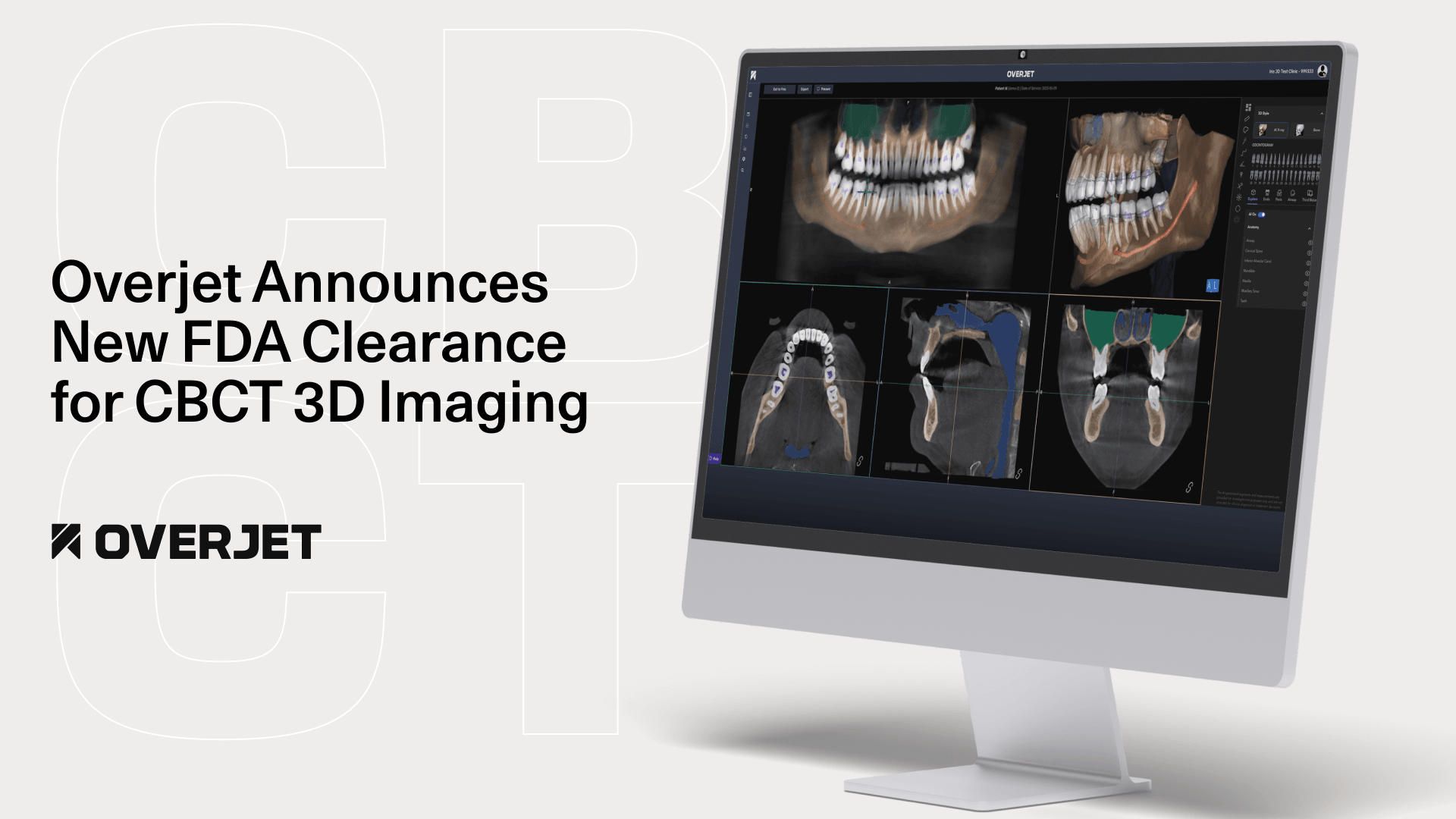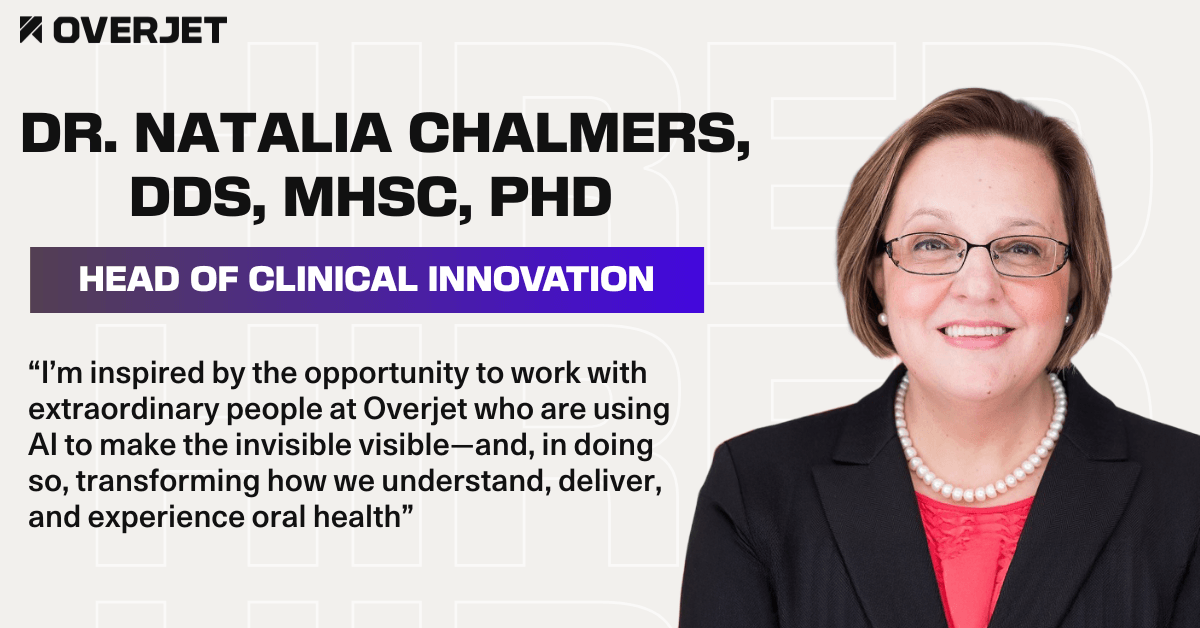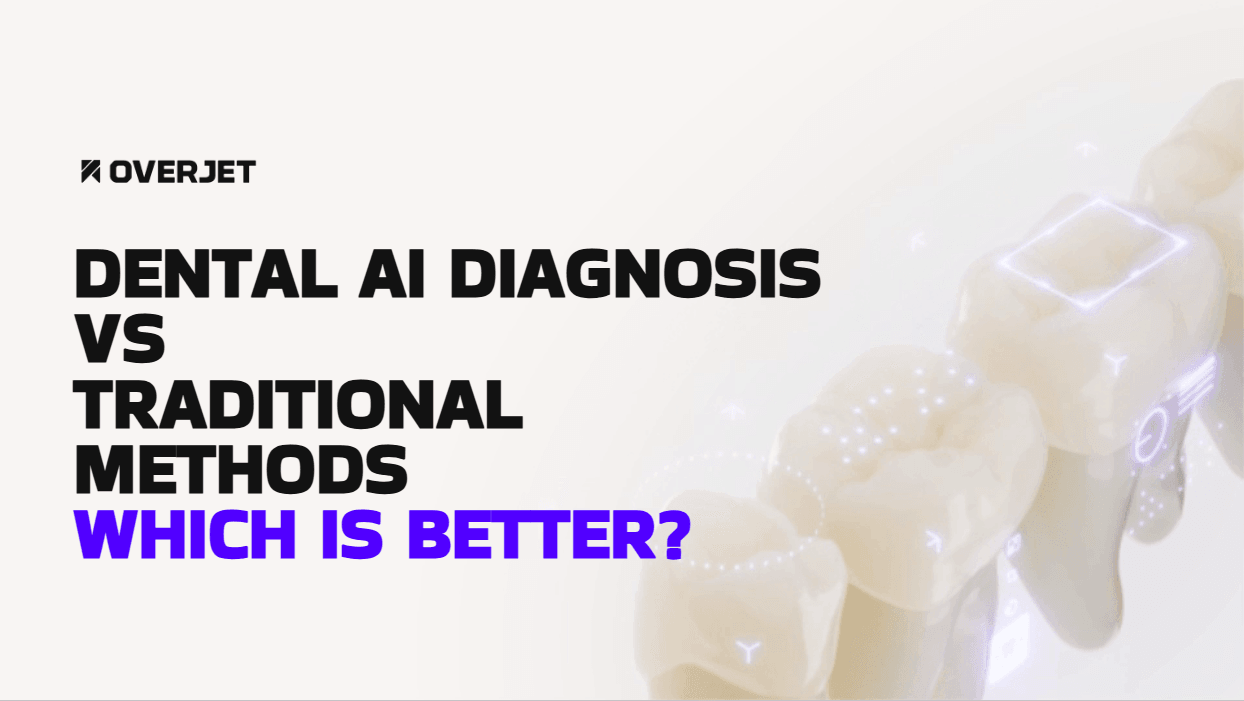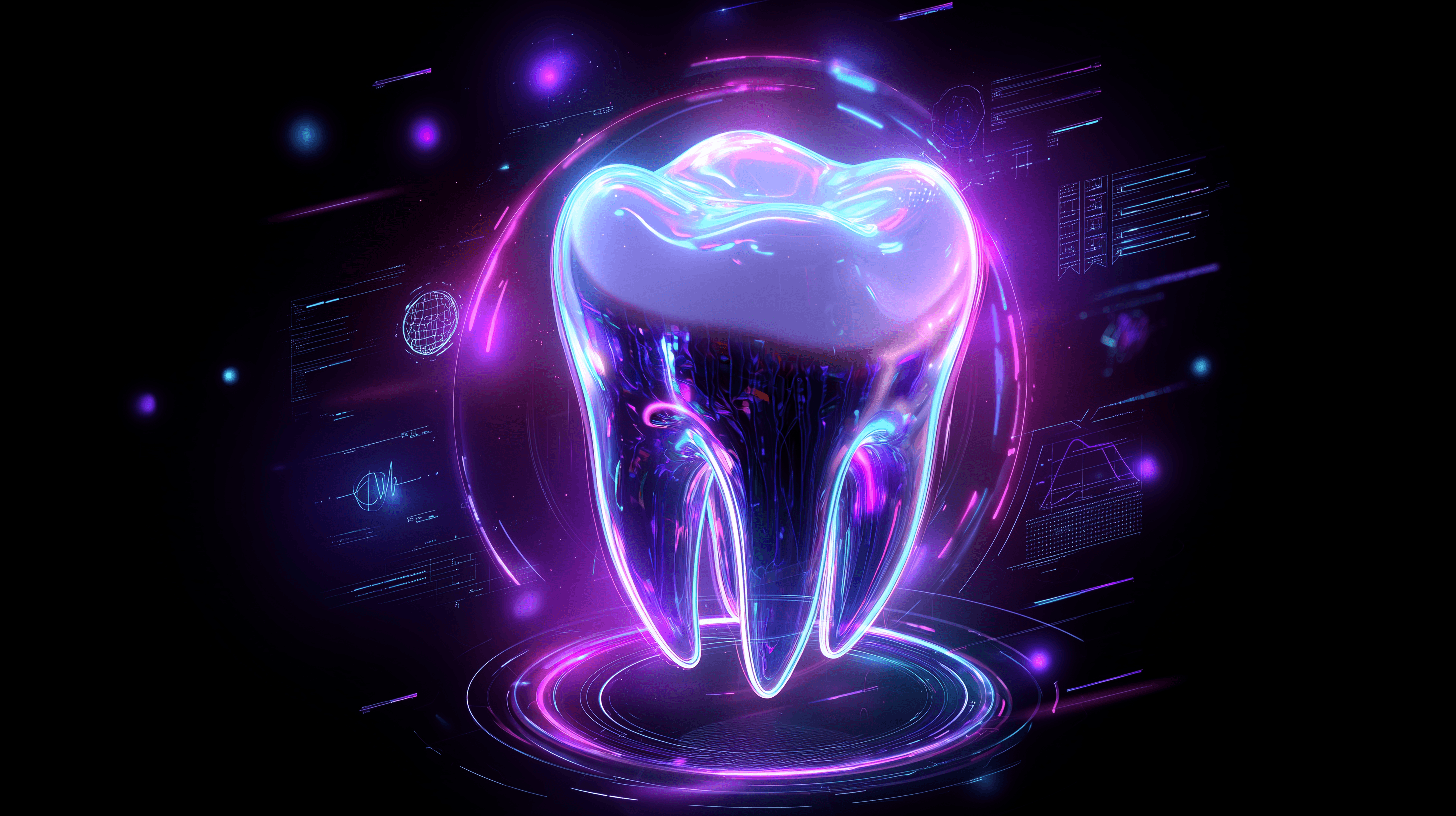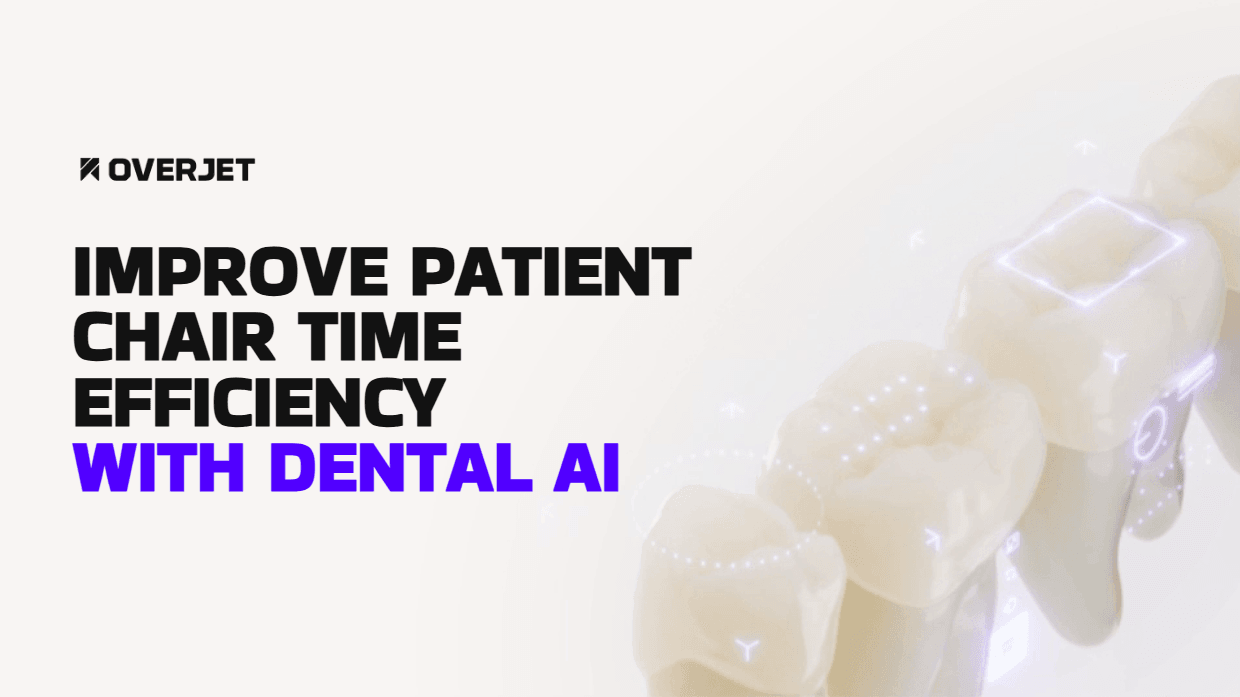Dental imaging has come a long way—from traditional film to 2D digital radiography, and now to powerful 3D imaging technologies like cone beam computed tomography (CBCT). As dental diagnostics become more complex, the rise of artificial intelligence (AI) is transforming how clinicians interpret and act on these detailed datasets.
In this blog, we’ll explore how 3D dental imaging combined with AI-driven software is elevating diagnostic precision, patient outcomes, and operational efficiency—and why Overjet Dental AI is leading the way in this transformation.
What Is 3D Dental Imaging?
3D dental imaging, most commonly performed using cone beam computed tomography (CBCT), has revolutionized the way dental professionals diagnose and plan treatment. Unlike traditional 2D X-rays, which offer flat, limited views of the mouth, CBCT scans provide high-resolution, three-dimensional images of the teeth, jawbone, nerves, sinus cavities, and surrounding structures.
This volumetric imaging gives clinicians an in-depth understanding of a patient’s oral anatomy from multiple angles, enabling more precise evaluations and surgical planning.
Key Benefits of 3D Dental Imaging:
Enhanced visualization for procedures such as dental implants, endodontic therapy, oral surgery, and orthodontics
Accurate measurement of bone density, volume, and proximity to anatomical landmarks
Better detection of complex or hidden pathology, including fractures, cysts, root anomalies, and impacted teeth
3D imaging is especially valuable in cases that require detailed spatial understanding, such as implant placement near nerve pathways or evaluating the root canal anatomy before endodontic treatment.
However, with the improvement in image detail comes a new challenge: a significant increase in data volume. A single CBCT scan may contain hundreds to thousands of slices, requiring time and attention to review thoroughly. This added complexity can slow workflows, introduce inconsistencies in interpretation, and increase the risk of missed findings—especially in busy, high-volume practices.
That’s where AI integration becomes essential, helping clinicians manage and interpret this vast amount of data quickly, consistently, and accurately.
See AI Dental Imaging in action
Challenges of 3D Imaging Without AI
While 3D dental imaging, particularly through CBCT, offers unmatched anatomical detail, the sheer volume of data it generates can create significant challenges for clinicians. A single CBCT scan can include thousands of image slices, each requiring careful review to ensure nothing is missed. For time-strapped dental teams, manually interpreting these scans can be overwhelming.
In busy practices and DSOs, where efficiency is critical, this complexity can lead to workflow bottlenecks, inconsistent diagnoses, and diagnostic fatigue—making it difficult to fully leverage the clinical power of 3D imaging.
Key Challenges Without AI:
Overwhelming Data Volume: Reviewing each slice of a CBCT scan is time-intensive and requires high attention to detail, especially in full-arch scans or multi-site diagnostics.
Diagnostic Variability: Without a standardized interpretation process, findings may differ between providers, leading to inconsistent treatment recommendations.
Time Constraints: High-volume practices often cannot dedicate the time needed for full, thorough reviews, which may compromise diagnostic accuracy.
Risk of Missed Pathology: Subtle abnormalities—such as root fractures, periapical lesions, or incipient bone loss—may go undetected in a manual review.
This is where AI plays a critical role. By automating the review process and applying intelligent algorithms to highlight key findings, AI reduces interpretation time, improves diagnostic consistency, and helps clinicians focus on patient care—not data overload.
Overjet’s dental AI platform is designed to meet these exact challenges head-on, enabling practices to scale high-quality diagnostics across all providers and locations.
How AI Enhances 3D Dental Imaging
As dental practices adopt more advanced imaging technologies like CBCT, the need for intelligent tools to manage, interpret, and act on that data becomes essential. That’s where artificial intelligence (AI) steps in—not to replace clinicians, but to enhance their expertise and streamline their workflows.
AI acts as a clinical co-pilot, analyzing 3D scans in real-time to identify anatomical structures, flag abnormalities, and surface actionable insights that may otherwise go unnoticed. It helps reduce diagnostic variability while supporting more confident, faster treatment planning.
Key Enhancements AI Brings to 3D Imaging:
Automated Pathology Detection: AI algorithms can highlight areas of concern such as bone loss, lesions, or impacted teeth—ensuring no key finding is missed.
Quantitative Measurements: AI provides consistent bone density, volume, and spatial measurements, essential for procedures like implant planning or surgical assessment.
Standardized Review Across Providers: With AI, diagnostic analysis becomes consistent across all providers and locations, which is critical for DSOs and group practices.
Faster Diagnosis and Planning: AI dramatically reduces the time required to review complex scans, enabling clinicians to deliver efficient, same-day care when possible.
By integrating AI into 3D imaging workflows, dental teams can make more informed decisions, improve diagnostic accuracy, and provide a higher standard of care. With platforms like Overjet, practices gain the ability to turn data-heavy CBCT scans into clear, confident treatment pathways—improving both efficiency and outcomes.
Why Overjet Is the Ideal AI Partner for Dental Imaging
As dental practices and DSOs embrace more advanced imaging modalities, choosing the right AI partner is critical to realizing the full potential of those technologies. Overjet stands out as the industry’s most trusted and innovative dental AI platform—designed to elevate diagnostic accuracy, standardize care, and improve patient outcomes at scale.
Currently, Overjet is FDA-cleared for detecting caries and measuring bone levels in 2D radiographs, offering real-time, AI-powered overlays that highlight pathology and support faster, more confident diagnosis. But Overjet’s capabilities don’t stop there. The platform is rapidly advancing toward 3D imaging integration, making it a future-ready solution for practices adopting CBCT and volumetric imaging.
The Overjet Advantage:
FDA-cleared AI platform with real-time radiographic analysis and clinically validated insights
Seamless integration with major digital imaging and practice management systems, ensuring a smooth workflow
Provider performance dashboards that offer visibility into diagnostic trends and help standardize care across teams and locations
Patient communication tools that use annotated visuals to explain diagnoses, increasing case acceptance and trust
Enterprise-ready infrastructure built to support solo practices, multi-site groups, and national DSOs alike
Whether you're currently relying on 2D imaging or expanding into 3D, Overjet delivers the clinical intelligence and operational support needed to drive smarter, more consistent care. It’s more than just software—it’s a platform that empowers teams and transforms dental practices.
Clinical and Operational Benefits of AI-Powered 3D Imaging
Integrating AI with 3D dental imaging is more than a technological upgrade—it’s a transformative shift that enhances diagnostic accuracy, improves clinical workflows, and elevates the overall patient experience. By automating complex data analysis and standardizing interpretation, AI allows dental teams to deliver higher-quality care with greater efficiency and consistency.
AI-powered 3D imaging supports early and accurate detection of pathology that might otherwise be missed during manual interpretation. Whether it’s identifying bone loss, anatomical variations, or subtle lesions, AI helps clinicians diagnose with confidence and precision.
Beyond diagnostics, AI also improves patient communication. By visually highlighting areas of concern within a 3D scan, clinicians can explain treatment needs more clearly, helping patients understand their condition and commit to care plans more readily.
For group practices and DSOs, the benefits multiply. AI ensures standardized interpretation across providers and locations, reducing variability and supporting better outcomes at scale.
Key Benefits of AI-Powered 3D Imaging:
Early, accurate detection of complex or hidden pathology
More engaging consultations through visual, patient-friendly explanations
Reduced diagnostic variability, especially in multi-provider settings
Increased provider confidence and streamlined onboarding for new clinicians
Better compliance and audit-ready documentation for insurance and regulatory needs
With Overjet, practices can unlock the full potential of their 3D imaging systems—turning high-resolution scans into high-impact results for both patients and providers.
The Future of Dental Imaging: 2D, 3D, and AI Together
The next generation of dental imaging isn’t about choosing between 2D or 3D—it’s about combining them under one intelligent platform, powered by AI.
Overjet is leading that future. As imaging technology continues to evolve, Overjet’s commitment to innovation ensures that practices can confidently adopt AI tools that elevate diagnostic quality, unify provider standards, and improve patient care.
Smarter Imaging Starts with Overjet
3D dental imaging unlocks a new level of clinical insight—and with AI, that insight becomes faster, clearer, and more consistent. Whether you’re already using CBCT or planning to expand your imaging capabilities, Overjet provides the AI solution that transforms how practices diagnose, communicate, and grow.
👉 Ready to optimize your imaging workflow with AI?
See AI Dental Imaging in Action
FAQs: 3D Dental Imaging and AI
1. What is 3D dental imaging, and how is it different from 2D X-rays?
3D imaging (usually CBCT) offers a volumetric view of dental anatomy, providing more detail than flat 2D X-rays. It’s ideal for complex cases like implants, endo, and surgery.
2. Does Overjet support 3D imaging?
Overjet currently leads in AI for 2D imaging and is developing enhanced support for 3D CBCT workflows, helping practices integrate AI across all imaging modalities.
3. How does AI help interpret 3D scans?
AI can automatically identify anatomical structures, detect abnormalities, and standardize measurements—reducing diagnostic time and variability.
4. Is AI imaging suitable for small practices or only DSOs?
Overjet’s AI platform is scalable and supports both solo providers and enterprise DSOs with flexible implementation options.
5. Will AI replace the dentist’s role in diagnosis?
No. AI is a decision support tool—it enhances accuracy and consistency but always keeps the dentist in control of clinical judgment.


